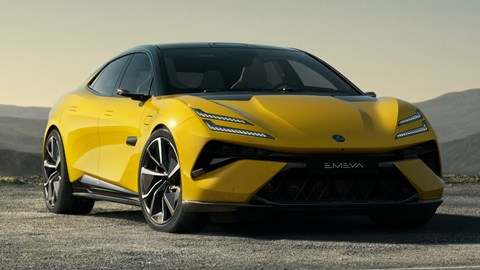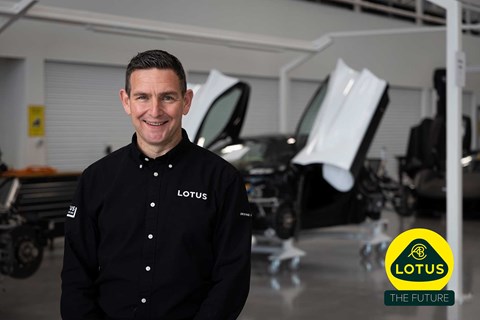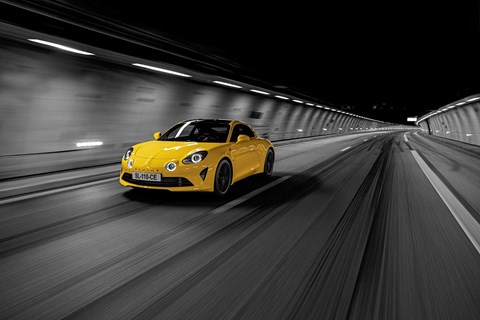► Electric two-seat Lotus sports car due in three years
► Line-up will be all-electric by 2028
► Insiders insist founder’s ethos remains relevant
The soundbite version of history would have you believe that Colin Chapman only ever said one thing: ‘Simplify, then add lightness.’ And that’s led to widespread scorn being heaped on the current Chinese-owned iteration of the company he founded in 1948 for its heavy, complicated electric cars. First the limited-run Evija hypercar, then the Eletre SUV, and now the Emeya GT, 2024’s intriguing rival for the Porsche Taycan, Audi e-Tron GT and Maserati GranTurismo Folgore.
But today’s Lotus employees continue to swear allegiance to Chapman, and emphasise some of the many other achievements and ambitious of this complex engineer, who died in 1982. Speaking at the London debut of the Emeya at the new Lotus showroom in Mayfair, they focused on his endless experimentation and his pioneering work in aerodynamics, weight distribution, monocoque chassis construction, active suspension and composites. He may not have been a cutting-edge inventor, but he had a keen eye for applying new ideas in innovative ways, and he was a great collaborator, with his own designers and engineers, and with outside companies including DeLorean.
Speaking at the Emeya event, chief commercial officer Mike Johnstone said: ‘They’ve embraced the Lotus heritage fully in China. There’s a huge picture of Colin Chapman in the lobby.’
He confirmed that the Type 135 was definitely on course for production, arriving after the Type 134 – a smaller SUV than the Eletre.

‘The Type 135, the sports car – that’s the bullsye. Everything else will sit around that.’
Engineering project leader Sylvain Verstraeten acknowledged that there was still a lot of work to do before an electric sports car could wear the Lotus badge, not least getting the right balance of power, range and weight.
‘The 100 per cent electric sports car will come. You lose some things but gain other things that improve the driving pleasure. There must be a good connection between the driver and the machine.’
Materials and sustainability expert Marie-Camille Lecoq noted: ‘Colin Chapman was always very modern in his thinking. We continue his mindset. We start at a minimum, as light as possible. “Do we need that? Is it good value?”
‘Some purists may say, “That’s not a Lotus”, but Lotuses have always embraced innovation, and we always keep in mind staying on brand.’
Design chief Ben Payne highlighted Chapman’s work with downforce, where he led the way in his Formula 1 years. And the interior and exterior look of the Emeya, Payne said, deliberately alluded to previous Lotus cars, including the S1 Esprit and the Eleven.
In 2028, 80 years after Lotus was established, the line-up will be all-electric. The aim is to be selling 150,000 cars a year by then, worldwide. Although the SUVs and the Emeya are built in Wuhan, the plan is for the Type 135 to be built at Hethel, initially alongside the Emira, but eventually replacing it.
Lotus partners with Britishvolt
Lotus has announced a new partnership with Britishvolt, whilst also revealing a new sketch of its latest all-electric sportscar. Despite having links to the likes of Polestar and Volvo, the Geely-owned brand confirmed its next sports car will use Britishvolt cells – admittedly powered by ‘advanced electric propulsion technologies developed by Lotus’.
‘Last year we committed Lotus to a pure electric future, and in the first month of this year we announce another significant step on that journey,’ said Matt Windle. ‘In the coming months we will be unveiling the Type 132, an all-new and all-electric Lotus SUV and we’ve confirmed three more EVs are on the way.’
The new partnership also follows a £100m investment by Lotus in its Hethel-based UK factory – and you can read more about the plan and the Type 132 below.

The Lotus plan
Lotus is going global, with a new headquarters for its Technology division being built in Wuhan, China. This new HQ will be a cornerstone in developing its all-in focus on pure electric cars, along with a massive £100m-plus investment in its Hethel headquarters and engineering capabilities. This new fleet of pure-EV Lotus models includes two new SUVs and a sports saloon.
CAR gained a world exclusive interview earlier in 2021 with new Lotus Cars managing director, Matt Windle, where he reveals that the brand’s future sports cars will all be electric, Chinese-built ‘lifestyle vehicles’ will also be zero-emission, and the brand is developing its own platforms – rather than relying on Geely ones.
Check this story’s links for more on the future of Lotus, but read on for key details of the company’s electrification plan.
Electric at the heart of Lotus’s 10-year plan
Matt Windle has been managing director since January 2021, though he began his second stint at Lotus in 2017 – the same year Lotus came under the majority ownership of China’s answer to the Volkswagen Group, Geely Holdings, and Malaysian car group Etika Automotive (which holds the other 49%). The new owners have pumped more than £100m into Lotus, including the construction of a new assembly hall at Hethel (pictured below).
Soon Windle was in charge of all UK product development, and intrinsically involved in writing Lotus’s 10-year business plan out to 2028, the company’s eightieth year.

‘When we wrote our product strategy, which was the start of the Vision80 plan, we just had to write EV into that,’ explains the 49-year-old boss. ‘With the legislation that’s come along, with the market data showing volumes are just going to grow and grow: the move towards electrification, it’s the right thing to do.’
Windle is no stranger to EVs: he worked at Tesla for seven years, getting the first Roadster into production at Hethel. ‘It made me realise what you can do with electric cars. They come with their challenges but also a lot of benefits: heat management, packaging, and if you put the batteries at the bottom, a car’s centre of gravity is much lower.’
The Emira: the last combustion-engined Lotus
Lotus has already shown the first car of the Vision80 plan, the Evija (below), a carbonfibre-monocoque-based pure-electric hypercar. Its four motors are claimed to produce a combined 2000PS (1973bhp), which would make it the most powerful road car in history. The price tag? £2m a pop.

While the Evija is limited to 130 units (as befits its 130 type number), the Emira – internally known as Type 131 before its reveal – is the first series-production model of the new era.
‘We’re not doing any hybrid drivetrains, because we’re going straight to electric,’ states Matt Windle. ‘Type 131 is basically the bridge to the new era of Lotus cars: it’s our last internal-combustion-engine car.’
Emira is a mid-engined sports car to replace the outgoing Elise/Exige/Evora. It’ll enter Lotus’s revamped retailers in early 2022.
Lotus SUVs on bespoke vehicle architecture
Also in development are two new vehicle architectures, one to support four-door ‘lifestyle vehicles’ such as crossover/SUVs, the other to underpin pure-electric sports cars. Neither is planned to accommodate combustion engines – and they are engineered by Lotus. Two new SUVs will arrive – one for the E segment (Porsche Cayenne, BMW X5, Audi Q7 etc.) in 2022 and one for the D segment in 2025 (Alfa Stelvio, Porsche Macan, Maserati Grecale etc.).
Lotus SUV mule spotted
What’s Windle’s vision for such a car? ‘The aesthetics have to be right, it has to be desirable. It has to drive like a Lotus, even if there’s more weight and it’s bigger. There’s no reason why you can’t have best handling and dynamics.’
‘We’re not using Geely architectures,’ explains Windle. ‘We have access to those architectures, but one of the things which shows the intent for Lotus is that we’re designing our own architectures. [One of those] will be a lifestyle car architecture.’ On top of the SUVs, another car to use this will be an E segment saloon (BMW 5-series, Audi A6 etc.) coming in 2024.
Revealed: Lotus’s global expansion plans – and keen price for next sports car
Lotus will glean some insights from partnering with Jenson Button’s Extreme E race team: it’s an appropriate crucible for the new Lotus, mixing motorsport, off-road vehicles and pure-electric power.
And a pure-electric sports car – in tandem with Alpine
Also in the pipeline is a pure-electric sports car architecture. ‘We have a programme running called LEVA (lightweight electric vehicle architecture), with government backing,’ says Windle. ‘We have ambitions to get an electric sports car to a similar weight to where combustion-engine sports cars are now.’
Discussing LEVA, Windle’s passion for engineering shines through. He started as a manual draftsman at camper van maker Dormobile, then learned computer-aided design at Daewoo in Worthing before joining Lotus for the first time in 1998.
‘We think we can [achieve our goal] through clever design, integration of systems – at Lotus we have our really happy moments if we get one part to do two jobs!’ Innovative materials will also play a part.

One of LEVA’s beneficiaries will be Renault’s sports-car division Alpine. The two companies are exploring shared technical resources and looking at combined motorsport opportunities. ‘The main one is co-developing a sports car together, which will be based off the electric sports-car platform we have in design now,’ says the boss.
He’ll be vital in developing the relationship between Alpine and Lotus: he knows his French counterparts well, having worked for Caterham when it was trying to develop a version of the A110 sports car (below). Unfortunately a lack of funding killed the Caterham.
‘I think Lotus and Alpine fit very well together: we’re of the same mentality, the same aspirations. And we kind of complement each other in market spaces as well: they could help us in Europe, and we could help them in the US. So I think there are really good opportunities there for both brands,’ concludes Windle.